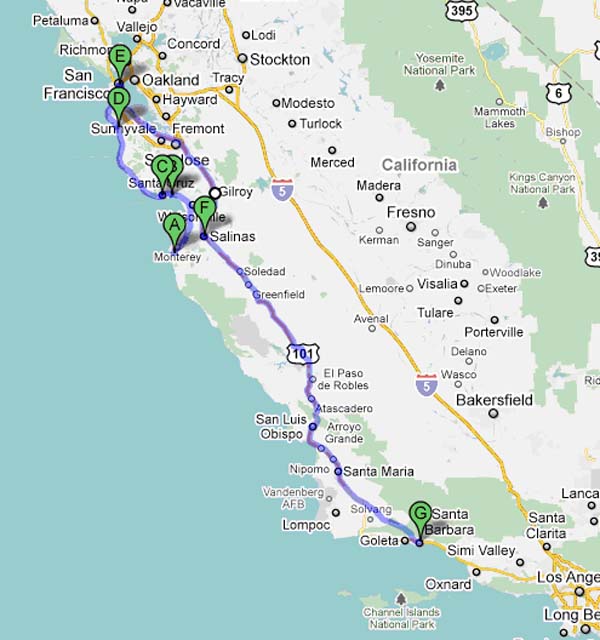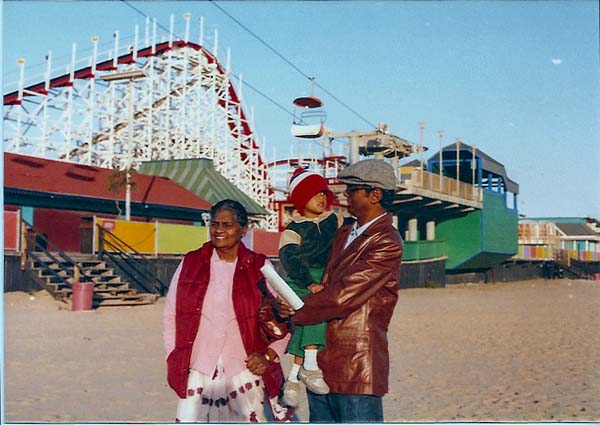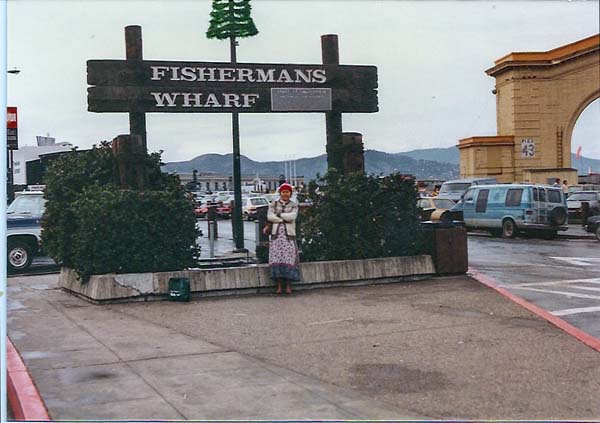The Travels of a Journalistâ€â€ÂÂ25 (Part A) -CALIFORNIA EXPLOITS: UNCOVERING SAN FRANCISCO WITH FAMILY
Posted on May 1st, 2010
By Shelton A. Gunaratne ƒÆ’-¡ƒ”š‚©2010
The San Francisco Bay Area (comprising nine counties, 101 cities, and 8,000 sq miles or 22,000 sq km) is home to some 7.4 million people. But the combined city-county of San Francisco (occupying a land area of 47 sq miles or 121 sq km) has a population of only about 810,000. It is, therefore, the fourth most populous city in CaliforniaƒÆ’‚¢ƒ¢-¡‚¬ƒ¢¢”š¬‚after Los Angeles (3.8 million), San Diego (1.3 million) and San Jose (1 million).
I first visited San Francisco in late December 1966ƒÆ’‚¢ƒ¢-¡‚¬ƒ¢¢”š¬‚exactly 17 years beforeƒÆ’‚¢ƒ¢-¡‚¬ƒ¢¢”š¬‚as a World Press Institute fellow. I had revisited it several times. Therefore, I arranged the current (1983) trip primarily for the benefit of Junius and Yoke-Sim. Mother would have been happier relaxing in the condo in Fullerton rather than going through the hassles of imposed sightseeing. She became a globetrotter because her children and grandchildren were dispersed in Australia, England, Germany, Sri Lanka and the United States; and not out of geographical curiosity.
On the Way
ƒÆ’-¡ƒ”š‚ After leaving Monterey Tuesday (20 Dec.) afternoon, we took the coast-hugging scenic SR1 to reach San Francisco, 126 miles (203 km) northwest of Carmel. At the northern point of Monterey Bay, we stopped briefly at Capitola (pop. 10,000) to admire the Begonia Gardens. Capitola is the town that thousands of birds, mostly sooty shearwaters affected by domoic acid poisoning, attacked in 1961. Alfred Hitchcock, ƒÆ’‚¢ƒ¢-¡‚¬ƒ…-the Master of Suspense,ƒÆ’‚¢ƒ¢-¡‚¬ƒ”š‚ who was a frequent visitor to the nearby city of Santa Cruz (pop. 56,000) used this unusual attack as the factual basis for his 1963 movie, ƒÆ’‚¢ƒ¢-¡‚¬ƒ…-The Birds,ƒÆ’‚¢ƒ¢-¡‚¬ƒ”š‚ overtly based on the 1952 novella ƒÆ’‚¢ƒ¢-¡‚¬ƒ…-The BirdsƒÆ’‚¢ƒ¢-¡‚¬ƒ”š‚ by Daphne de Maurier.
Although the Santa Cruz Beach Boardwalk was not in operation during weekdays in winter, yet we stopped there to get a close look at CaliforniaƒÆ’‚¢ƒ¢-¡‚¬ƒ¢-¾‚¢s oldest surviving amusement park dating back to 1915. The Giant Dipper roller coaster, one of the best-known wooden coasters in the world, dominates the eastern end of the boardwalk.ƒÆ’-¡ƒ”š‚ All of us enjoyed walking on the boardwalk along Beach Street.
Back on SR1, we drove 50 miles further north to Half Moon Bay (pop. 11,400), and another 30 miles (48 km) to San Francisco, which we reached about 6 p.m. We had booked accommodation with Trinity Inn. However, when we tried to register, a man told us that the inn has closed down and directed us to Adelaide Inn (5 Adelaide Place). We complied. The charge was $35 per night with $3.50 extra to park our car at the Turk Street Garage. (Located close to Union Square, the inn bears the current name Adelaide Hostel and the address 5, Isadora Duncan Lane.)
Thumbnail of Frisco
Wikipedia gives the following thumbnail sketch of San Francisco (derided as Frisco):
San Francisco is a popular international tourist destination renowned for its steep rolling hills, eclectic mix of Victorian and modern architecture, and famous landmarks, including the Golden Gate Bridge, Alcatraz Island, the cable cars, Coit Tower, and Chinatown. The city is also known for its diverse, cosmopolitan population, including large and long-established Asian American and LGBT communities. It is the second most densely populated city in the United States, behind only New York City and from the time of the Gold Rush until the 1920s it was the largest city in California in terms of population. It was also one of the first cities in California to be incorporated, and is the only consolidated city-county in the state of California.
Wikipedia, launched on 15 Jan. 2001, is a creation of this century. But its sketch of the city is applicable to what San Francisco was like in 1983, as well. During our five-day sojourn, we managed to uncover most of the unique features and characteristics of the city adumbrated above. Except on Day 1 (Wednesday, 21 Dec.), when mother and Junius decided to rest in the hotel room, all of us together uncovered the city.
While fact-checking this essay, I noticed a glaring discrepancy between everyoneƒÆ’‚¢ƒ¢-¡‚¬ƒ¢-¾‚¢s desire to make San Francisco his/her preferred habitat and the cityƒÆ’‚¢ƒ¢-¡‚¬ƒ¢-¾‚¢s loss of some 45,000 residents between my first visit in 1966 and the current in 1983.
Uncovering Northeast
On Day 1(Wednesday), when Yoke-Sim and I set off on a self-guided walking tour, what we basically did was to orient ourselves to the northeast section of San Francisco that included Union Square, Chinatown, Jackson Street Historical District, North Beach (tenderloin area), Telegraph Hill (Coit Tower), FishermanƒÆ’‚¢ƒ¢-¡‚¬ƒ¢-¾‚¢s Wharf and Embarcadero (the eastern waterfront road of the Port of San Francisco, along the San Francisco Bay; roughly meaning ƒÆ’‚¢ƒ¢-¡‚¬ƒ…-place of embarkationƒÆ’‚¢ƒ¢-¡‚¬ƒ”š‚).
Because climbing up Telegraph Hill would have been too tedious, we took a No. 39 bus from Washington Square to Pioneer Park atop Telegraph Hill, where Lillie Hitchcock Coit built the Coit Tower in 1933. Architects Arthur Brown Jr. and Henry Howard designed the art deco tower, 210 feet (64 m) of unpainted reinforced concrete, with murals by 26 different artists and numerous assistants. We had a 360-degree view of San Francisco from the tower.
FishermanƒÆ’‚¢ƒ¢-¡‚¬ƒ¢-¾‚¢s Wharf is another indispensable landmark of San Francisco. It is best known for being the location of Pier 39, San Francisco Maritime National Historical Park, the Cannery Shopping Center, Ghirardelli Square, a Ripley’s Believe it or Not museum, the MusƒÆ’†’ƒ”š‚©e MƒÆ’†’ƒ”š‚©canique, the Wax Museum at Fisherman’s Wharf, Forbes Island and restaurants and stands that serve fresh seafood, most notably Dungeness crab and clam chowder served in a sourdough bread bowl.
Alcatraz Island (ƒÆ’‚¢ƒ¢-¡‚¬ƒ…-The RockƒÆ’‚¢ƒ¢-¡‚¬ƒ”š‚) lies in the San Francisco Bay, 1.5ƒÆ’-¡ƒ”š‚ miles (2.4ƒÆ’-¡ƒ”š‚ km) offshore from San Francisco. It has served as a lighthouse, a military fortification, a military prison, and a federal prison until 1963. Later, in 1972, Alcatraz became a national recreation area and received land-marking designations in 1976 and 1986. Now, the National Park Service operates the island as a historic part of the Golden Gate National Recreation Area. Although we did not take the ferry ride to Alcatraz, we viewed it from the museum ship Eureka when we visited the Hyde Street Pier off the Embarcadero.
Family Waking Tour
On Day 2 (Thursday), all of us went on a walking tour of the city in spite of the continual drizzle and the grey skies.ƒÆ’-¡ƒ”š‚ The highlight was a tour of the Old U.S. Mint, which opened in 1854 to accommodate the Gold Rush (1848-1855) and moved into the current premises in 1974. My mother was extraordinarily impressed with the visual delight of hobnobbing with stacks of gold bars. At the Civic Center, we joined a tour of the magnificent City Hall (1915) with its soaring rotunda constructed of California granite to look like the U.S. Capitol. Our tour guide was a Chinese American woman, who took us to see the chamber of the board of supervisors and explained the significance of the artwork. She permitted us to peep into the opera house, the symphony hall and the civic auditorium.
We started the day with a visit to St MaryƒÆ’‚¢ƒ¢-¡‚¬ƒ¢-¾‚¢s Cathedral of the Assumption, a structure made of Italian marble, on Cathedral Hill; then tarried at the Japan Center (Nihonmachi). We closed the day with a car trip to Mission San Francisco de Asis (built in 1776), the oldest surviving structure in the city. We stopped at the top of Twin Peaks to see how the city looked like on a rainy evening. Then, we drove to Sacramento Street (between Broderick and Cherry) and Union Street (between Fillmore and Van Ness) to see an abundance of Victorian architecture.
To celebrate motherƒÆ’‚¢ƒ¢-¡‚¬ƒ¢-¾‚¢s visit to San Francisco, we treated ourselves to a sumptuous Indian-style dinner at Pasand Lounge (1875 Quincy St.).
ƒÆ’-¡ƒ”š‚ Next: To be continued (Part B)
(The writer is a professor of mass communications emeritus, Minnesota State University Moorhead.)

Figure 1 From A=Monterey to E=San Francisco via B=Capitola, C=Santa Cruz and D=Half Moon Bay. Return to Fullerton via F=Salinas and G=Santa Barbara
Picture 1: The Giant Dipper roller coaster, one of the best-known wooden coasters in the world, dominates the eastern end of the boardwalk.ƒÆ’-¡ƒ”š‚ All of usƒÆ’‚¢ƒ¢-¡‚¬ƒ¢¢”š¬‚including the author, his mother and son (pictured)ƒÆ’‚¢ƒ¢-¡‚¬ƒ¢¢”š¬‚enjoyed walking on the boardwalk along Beach Street (20 Dec. 1983).
Picture 2: FishermanƒÆ’‚¢ƒ¢-¡‚¬ƒ¢-¾‚¢s Wharf is another indispensable landmark of San Francisco. Yoke-Sim stands at the entrance to the wharf (21 Dec. 1983).
ƒÆ’-¡ƒ”š‚

